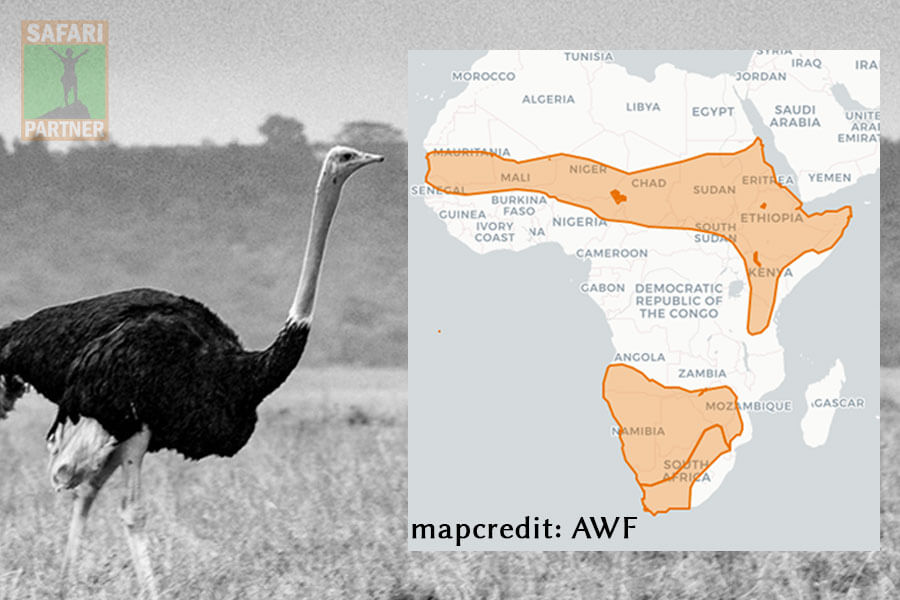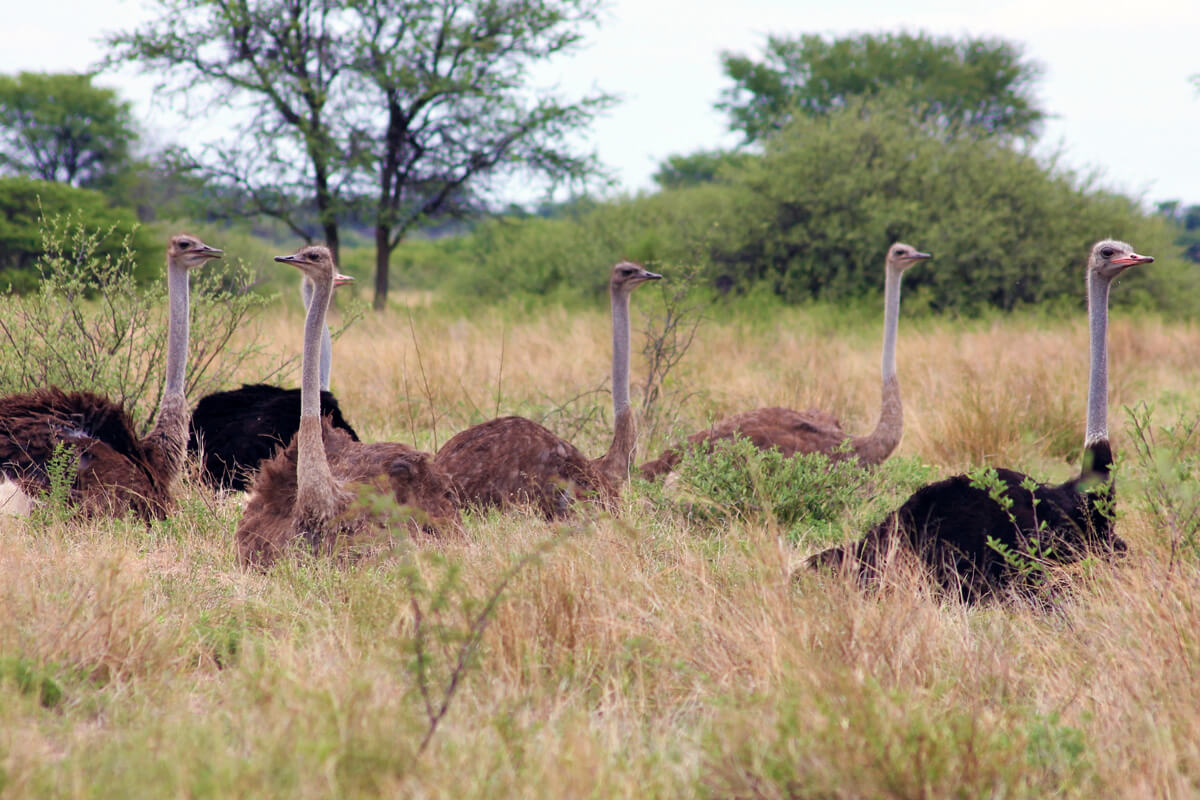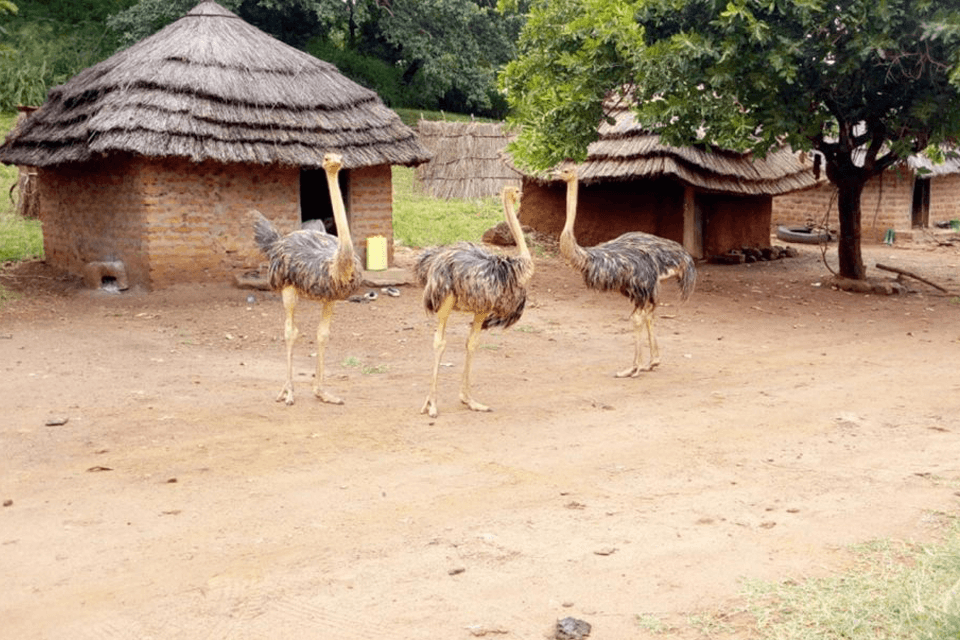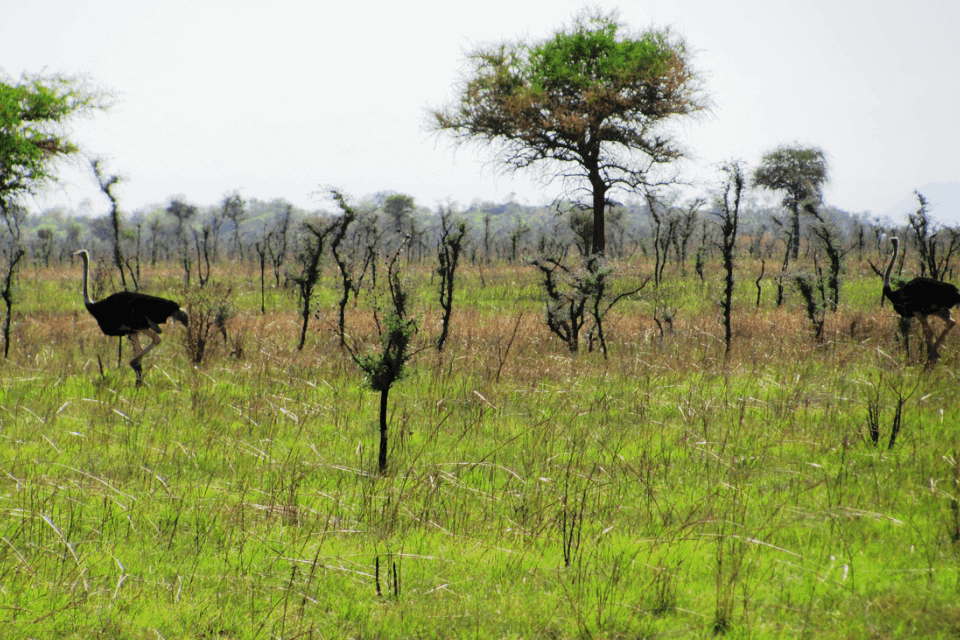Ostriches are the largest species of birds in the world and are well known for their impressive size and striking appearance. Beyond their physical attributes, Ostriches are very interesting birds with a lot of biological and behavioural adaptations to survive and thrive in their natural habitat.

In this article, we'll delve into some of the most interesting facts about ostriches and bust some popular myths that people hold about ostriches. From their unique physical features to their behaviours and habitat, you will get very well acquainted with Ostriches and their lives.
Facts About Ostriches
1. How Big Is An Ostrich?
Ostriches are the largest birds in the world, with some males standing up to nine feet tall and weighing over 150 pounds. Female ostriches are generally smaller, with a height of around six to seven feet and a weight of around 90 to 120 pounds.
In addition to their size, ostriches are also known for their striking appearance, with their black and white plumage, bare skin on their legs and neck, and distinctive long eyelashes.
2. Where Do Ostriches Live?
Ostriches are native to Africa, where they are found throughout much of the continent, except for the dense rainforests in the central and western parts of the continent and the highlands of East Africa. Ostriches are adapted to a variety of habitats, including grasslands, savannas, and deserts.

Ostriches are not found in the wild outside of Africa, although they are kept in zoos and aviaries around the world. In captivity, ostriches are often kept in enclosures that mimic their natural habitat, with plenty of space to roam and access to food and water.
Related article: Where do Ostriches live in the wild?
3. How Long Do Ostriches Live?
Ostriches can live for up to 40 years in the wild. In captivity, they may live even longer, with some individuals living into their 50s or 60s. The lifespan of an ostrich can be affected by several factors, including diet, habitat, and access to healthcare.
In the wild, ostriches face many threats, including predation by other animals, poaching, and disease, which can affect their lifespan. However, these birds are generally hardy and can withstand a wide range of environmental conditions.
Related article: Comparing the lifespan of popular African wild animals
4. Can Ostriches Fly?
Their wings are also relatively small compared to their body size, as they are not adapted for flight. Instead, they use their wings for balance when running at high speeds and for courtship displays.
While ostriches are not able to fly, they do use their wings for balance when running at high speeds. They also use their wings for courtship displays and to protect their eggs and young.
5. Do Ostriches Have Good Vision?
Ostriches have excellent eyesight and hearing, which helps them detect potential threats. They also have a keen sense of smell, which they use to locate food and water.
6. Why Do Ostriches Have Bare Skin?
Ostriches have bare skin on their legs and neck. This bare skin helps dissipate heat, which is important in the hot, dry climates where ostriches live.

7. How Do Ostriches Reproduce?
Like any other bird, a female (hen) ostrich reproduces by laying and hatching eggs. The Ostrich often lays between 12 and 18 eggs in a year.
After the eggs are laid it is the responsibility of the male ostrich to incubate and look after the eggs for around 45 days until they hatch.
Ostriches reach sexual maturity at around two to four years of age and are fully grown by the time they are about five years old. After reaching sexual maturity, ostriches can continue to grow and develop until they are around 10 years old.
8. How Big Is An Ostrich Egg?
Ostriches lay the largest eggs in the world, with some eggs weighing up to three pounds. These eggs are also among the largest in terms of volume, with a single egg containing the equivalent of about two dozen chicken eggs.
9. Do Ostriches Eat Their Eggs?
It is not uncommon for ostriches to eat their own eggs, especially if the eggs are infertile or if the female is unable to incubate the eggs for some reason. Ostriches are known to consume their own eggs for a variety of reasons, including as a source of nutrition and to recycle calcium and other nutrients.
In the wild, ostriches often lay their eggs in communal nests, where multiple females lay their eggs in the same nest. In these situations, some female ostriches could consume eggs that are not their own as a way to reduce competition for resources.
It is worth noting that while ostriches do occasionally consume their own eggs, they are also known to aggressively defend the eggs from any potential predators.
10. Do Ostriches Mate For Life?
Unlike some other bigger birds, Ostriches do not mate for life and are rather polygamous, meaning that males mate with multiple females. The male will establish a territory and attract females to his harem by performing his courtship dance.

11. Are Ostriches Smart?
Intelligence in animals is usually determined based on the ability to learn, adapt and cooperate as a group. With that in mind, ostriches can be regarded as intelligent birds.
The social structure of a flock is organized, they form strong bonds with each other and have been observed to use tools such as sticks to dig for food. ostriches can also communicate through various vocalizations and body language - a characteristic of other intelligent animals and birds.
Overall, ostriches are highly adaptable and possess a range of cognitive abilities that enable them to thrive in their natural environment.
12. Can Ostriches Hurt Humans?
Ostriches are generally not aggressive toward humans, and attacks are rare. However, like any other animal, ostriches can be dangerous if they feel threatened or perceive a human as a threat to their young.
Ostriches have powerful legs that can be used for kicking. Additionally, they can run very fast at around 45 miles per hour which means they could chase and catch any human running at full speed.
In the wild, visitors usually keep a safe distance from the ostriches and follow guidelines on respecting the wildlife of the national park or protected area. Therefore, a visit to see Ostriches in the wild is considered very safe for both humans and birds.
13. Do Ostriches Make Good Pets?
Ostriches are not typically kept as pets due to their large size and special care requirements. These birds are adapted to living in wide open spaces, where they have plenty of room to roam and forage for food.
Ostriches are also wild animals and are not typically domesticated. They can be unpredictable and can be dangerous if they feel threatened or if they perceive a human as a threat to their young.
In addition, ostriches have special dietary and healthcare needs that can be difficult to meet in a domestic setting. They require a diet that includes a variety of plant matter, insects, and small mammals, and they may also need access to grit or other sources of calcium to maintain their health.
Overall, while ostriches may be fascinating to observe, they are not well-suited to life as pets and are best left in their natural habitat or the care of professionals in a zoo or aviary setting.

14. Are Ostriches Social?
Ostriches are social birds that live in groups, called flocks. These flocks can be made up of several birds or as many as 50 or more birds. The flock is usually led by a dominant male, called a cock, who will mate with several females, called hens.
Within the flock, Ostriches have a hierarchical social structure, and dominance is established through displays of aggression and dominant behaviours such as pecking, biting, and charging.
Ostriches also have a communal breeding system, where several females will lay their eggs in a single nest, which is tended to and incubated by the dominant male. Once the chicks hatch, the females take turns caring for and protecting the young.
In the wild Ostriches are nomadic birds, traveling around large areas of savanna or desert in search of food and water. In captivity, Ostriches will form smaller, stable flocks and are less nomadic.
15. What Do Ostriches Eat?
Ostriches are omnivorous, meaning that they feed on a wide range of plants and animals. Their diet includes fruit, seeds, insects, and small animals. In the wild, ostriches will forage for food, using their keen eyesight and sense of smell.
Ostriches are known to consume a variety of plant matter, including grasses, berries, and roots. They are also known to eat insects, such as beetles, grasshoppers, and termites. In some cases, ostriches will consume small mammals, such as rodents and hares, if they are available.

16. Do Ostriches Drink Water?
Ostriches can go without water for long periods, getting most of the moisture they need from the plants and animals they consume. However, they will also drink water if it is available, and are known to dig holes to find water in dry conditions.
17. Do Ostriches Drink Water?
Similar to any other animal, ostriches drink water and can't live without water. Unlike most other birds, ostriches are well-adapted to living in arid environments and can go without water for long periods.
They get most of the moisture they need from the plants and animals they consume.
18. What Kills Ostriches In The Wild?
Ostriches have few natural predators: Despite their size and strength, ostriches have few natural predators. They are vulnerable to attacks from large carnivores, such as lions and hyenas, but they are generally able to defend themselves with their powerful legs and speed.
Common Myths About Ostriches
A). How Many Stomachs Do Ostriches Have?
Similar to any other bird, ostriches have a single stomach. Their digestive system is similar to that of other birds, with a crop for storing food, a gizzard for grinding up food, and a small intestine for absorbing nutrients.
B). Can An Ostrich Carry A Human?
Ostriches are strong birds, but they are not typically able to carry a human because of their anatomy and size. Ostriches have long legs and small bodies, and while they can run at high speeds and be quite powerful, they are not built to carry heavy loads. They are also are flightless birds, so they not able to lift any objects off the ground, even with their strong legs.
C). How Many Hearts Do Ostriches Have?
Ostriches, like all birds, have only one heart. However, their heart is larger and more powerful than the hearts of most other birds, due to the demands of their size and the high level of physical activity they are capable of.
Any mention of an ostrich having more than 1 heart is simply one of those myths that are easily believable even though the science exists to prove otherwise.
Conclusion
Ostriches are fascinating creatures with many unique characteristics and behaviours. From their impressive size and powerful legs to their keen senses and social nature, there is much to learn about these remarkable birds.
If you ever have the opportunity to see ostriches in the wild, be sure to take the time to appreciate these incredible creatures and all that they have to offer.
